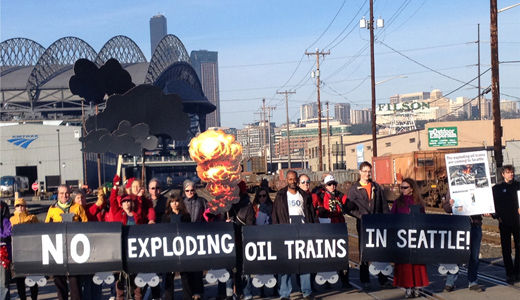
WASHINGTON – Environmentalists and rank-and-file railroad workers took to the streets in dozens of cities in the U.S. and Canada the week of July 6-12, protesting continued transportation of oil trains – freight trains hauling dozens of oil-laden tank cars through the two nations.
Railroads, however, brushed off complaints the tank cars are unsafe, despite two years’ worth of damaging accidents, starting with one explosion in July 2013 in Quebec where authorities later ruled the railroad was responsible for the blast that leveled the downtown of Lac-Megantic and killed 47 people. The latest, in June in Tennessee, forced evacuation of 5,000 people.
“Though it (Lac-Megantic) happened in Canada, the explosion forced a fierce discussion in America about whether we were doing enough to prevent similar incidents at home,” said Railroad Workers United, the rank-and-file group that includes members of the Teamsters and Smart’s rail conference.
“The volatile oil that caused the explosion, after all, came from North Dakota. And, safety advocates pointed out, that North Dakota oil was being shipped across America by train at a rate 40 times greater than just five years prior to the accident.
“Worse, there had been no upgrades in federal safety regulations to account for that increase. Canada had just experienced a major tragedy – it seemed like America was vulnerable to one as well. And the American public is still being kept in the dark.”
The oil tank car protests drew more environmentalists than rail workers, with several environmentalists being arrested on July 6 in Richmond, Calif., for draping an anti-oil train banner on a prominent bridge. In D.C., despite perfect weather, six environmentalists showed up at the U.S. Transportation Department headquarters with a “stop oil trains” banner.
But the protests have drawn some official action and attention.https://peoplesworld.org/admin
Federal officials issued new and final safety standards for the oil trains in May, imposing maximum speeds of 50 mph, except in urban areas, where the maximum is cut to 40 mph. The feds also ordered railroads to update their braking systems for the oil trains, and to better classify and report what hazardous materials – not just oil – the tank cars carry.
The Baltimore City Council held a hearing on July 1 on the hazard of oil trains moving through. A key freight tunnel, which frequently has tank cars running through it, passes just west of downtown Baltimore, diving underground near the armory, the symphony hall and an urban college campus. Environmentalists told the council 165,000 people live within a 1-mile “blast zone” radius of the tracks and the tunnel.
The federal rules are not good enough, the workers and their safety experts say. Fred Millar, a safety consultant, told ThinkProgress that residents of surrounding areas – blast zones, to use the demonstrators’ phrase – are still being kept in the dark about the oil trains.
That led to the protests in Richmond. Activists there tried to hang a 60-foot banner in front of the Benicia-Martinez railroad bridge. It read “Stop Oil Trains Now: Are You in the Blast-Zone.org.” The bridge runs near Valera, Tesoro, Shell and Chevron refineries. The rail industry says it’s part of the route for oil trains moving through the San Francisco Bay area.
Photo: Earthfirstjournal.org












Comments